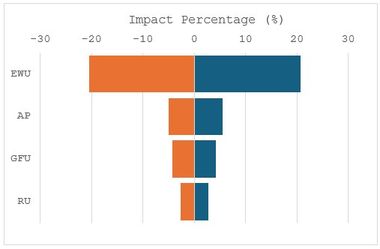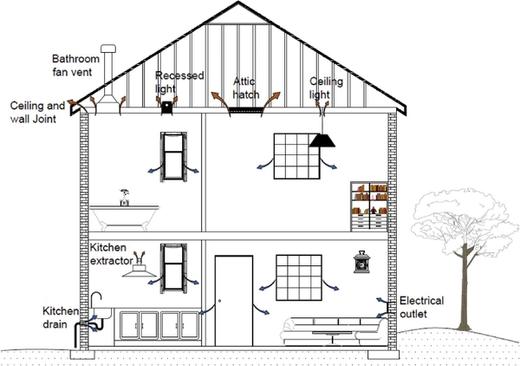Article
The rising importance of building performance measurement in the wake of RdSAP changes
The landscape of residential energy performance assessment is on the cusp of significant change with the June 2025 updates to the Reduced Data Standard Assessment Procedure (RdSAP). As the UK strives towards ambitious net-zero targets, an ever sharper focus is being placed on the energy efficiency of existing homes. Within this evolving framework, building performance measurement, and specifically air tightness testing, is set to become considerably more important.
RdSAP is the methodology used to calculate the Energy Performance Certificates (EPCs) for existing dwellings. The current version, RdSAP 9.94, relies on a combination of data collected during a site visit and default values based on the property's age and type. A key limitation of the current methodology is its reliance on these default values, often leading to a less accurate representation of the actual energy performance of a given individual home. The upcoming RdSAP 10, announced to go live on the 15th June 2025, marks a positive step forward by allowing Domestic Energy Assessors (DEAs) to incorporate the results of air pressure tests directly into their assessments. This seemingly small change has the potential to significantly impact EPC ratings and drive improvements in the way we assess the energy efficiency of the existing housing stock.
Why airtightness testing matters
Airtightness refers to the degree to which air can leak into or out of a building through unintentional gaps and cracks in its construction. Poor airtightness leads to:
- Increased Heat Loss: Draughts allow warm air to escape in the winter and cool air to escape in the summer, forcing heating and cooling systems to work harder and increasing energy consumption. Studies suggest that a significant portion of a home's heat loss can be attributed to poor airtightness.
- Higher Energy Bills: The increased demand on heating and cooling systems directly translates to higher energy bills for homeowners.
- Reduced Comfort: Draughts create cold spots and uneven temperatures within a home, impacting occupant comfort.
- Risk of Condensation and Mould: Uncontrolled air movement can carry moisture, leading to condensation within the building fabric, which can then result in mould growth and potential health issues.
- Inefficient Ventilation: In leaky buildings, ventilation is often uncontrolled and can lead to excessive heat loss or gain. The goal is to instead build tight and ventilate right, providing controllable mechanical ventilation alongside good levels of airtightness wherever practicable.
RdSAP 10: Integrating airtightness data
The inclusion of airtightness testing in RdSAP 10 addresses a significant limitation of the previous methodology. Currently, rdSAP uses default air permeability values based on the age and construction type of the dwelling, which may not accurately reflect the actual airtightness of the property. A well-sealed older property, for example, might be unfairly penalised by a generic default value.
By allowing DEAs to input the results of an air pressure test, also known as an airtightness test, RdSAP 10 will enable a more accurate assessment of a property's energy performance. If a property achieves a good airtightness score (a lower score indicates better airtightness), this can positively influence the overall EPC rating. As we have shared previously, we know default airtightness values to typically be on the high side, with many existing homes measuring as being more airtight than typically assumed.
Potential EPC point gains
The exact number of extra EPC points awarded as a result of an airtightness test result will depend on several factors, including:
- The initial airtightness of the property: if no upgrade measures are planned and a test is used to simply override the default value, the number of EPC points gained or lost will be influenced directly by the difference between the test result and the assumption. The more airtight the better and we observe many homes to measure as having an air permeability of 6-10, whereas the default value is most commonly 15 m3/m2h@50Pa.
- The target airtightness achieved: If upgrade measures have been installed which also reduce the air leakage, then there are even greater EPC point gains to be made over and above the default values, making the benefits of a test even more pronounced. It is common for retrofit works to deliver airtightness levels of 3-6 m3/m2h@50Pa, if not lower.
- The specific characteristics of the property: The impact of airtightness on the overall EPC rating is also considered within the wider context of other energy efficiency measures present in the dwelling, such as insulation levels, heating system efficiency, and renewable energy technologies.
While a precise figure is difficult to quantify without a specific property assessment using RdSAP 10, achieving a good airtightness result through testing and any necessary improvements could potentially increase an EPC rating by anywhere in the region of 1-3 points, possibly even moving a property up an entire EPC band in some cases. Given the EPC band thresholds, even a small improvement in the SAP score could translate to a noticeable gain in EPC points.
For example, a property with a poor default air permeability score might see a significant jump in its SAP rating if an airtightness test demonstrates a much better performance, potentially pushing it from a low C rating to a high C or even a B rating.
Given that the cost of a test is usually a very modest £200-£250, the cost per EPC point gain also makes airtightness testing an exceedingly cost-effective solution for landlords to include as a first step in any retrofit program of works.
What other metrics have the biggest positive impact on SAP scores?
According to research which is currently being carried out by Build Test Solutions and Loughborough University, U-values have the biggest singular impact on improving the results of an EPC. The external wall U-value has the most significant impact on SAP ratings, energy costs, and CO₂ emissions across all 12 archetypes that were studied.

This can be seen in the chart which shows that the external wall U-value (EWU) has a 20% impact on the total CO2 emissions, which is the greatest compared to the other input parameters. Furthermore, a 50% decrease in the external wall U-value results in an increase in SAP rating to 68 for the 1919-44 semi-detached housing archetype, making it the most influential factor for improving energy performance. This effect is due to the large surface area of the external walls especially when compared to the roof or ground floor. Thermal loss through the walls carries a significant contribution towards a building's overall thermal transmittance. A higher U-value means more heat is lost, leading to higher heating demand and increased energy costs. Alternatively, lower U-values mean improved insulation, reducing heating requirements and CO2 emissions. This further leads to a lower demand for energy, reducing primary energy consumption and operational costs and ultimately improving the SAP rating.
External wall value has noticeably the biggest single variable effect, this is shown by air permeability (AP), the second most impactful input, having a smaller range of EPC ratings, 61 to 64, compared to external walls range, 57-68.
This shows that any property owner looking for the simplest or cheapest possible way of improving a recording of any of the outputs is best suited to recording a measurement of external wall U-value.
With the government proposing that by 2030 an EPC rating of B must become the standard as well as a discussion that a rating of C will be the minimum legally required by landlords, moving up from E, having inaccurate and potentially lower than reality EPC ratings has near-future severe financial consequences for homeowners.
Additionally, EPC ratings tend to affect the price of a property on the market today. It is clear that accurate measurements will be needed to increase the chance of a property's EPC being improved, which is vital to ensuring potential future regulations are met.
Implications and Benefits
The integration of both airtightness testing and in-situ U-value measurements into EPCs has several important implications:
- Increased Accuracy of EPCs: EPCs will provide a more reliable reflection of a property's energy performance, empowering homeowners and potential buyers with more accurate information.
- Incentivising Energy Efficiency Improvements: Homeowners will be incentivised to invest in measures to improve the airtightness of their properties and reduce U-values of primary fabric components such as walls and roofs, as this can directly lead to a better EPC rating and potentially increase property value.
- Better Identification of Energy Saving Opportunities: Both U-value measurements and airtightness testing can pinpoint problem areas and identify what intervention will provide the best returns, allowing for targeted and effective upgrades.
- Support for Retrofit Initiatives: As the UK government pushes for the retrofitting of existing homes to meet energy efficiency targets, measurement and testing will play a crucial role in verifying the effectiveness of these measures.
- Alignment with New Build Standards: The inclusion of airtightness testing and U-values in rdSAP brings the assessment of existing dwellings closer in line with the requirements for new builds, where, for example, airtightness testing is already mandatory under Part L of the Building Regulations.
Conclusion
The upcoming changes to RdSAP, specifically the inclusion of airtightness testing results, mark a significant step towards a more accurate and comprehensive assessment of the energy performance of existing homes. While the precise number of extra EPC points achievable will vary, it is clear that good airtightness will be increasingly valued and reflected in EPC ratings.
This shift will not only provide homeowners with a clearer understanding of their property's energy efficiency but also incentivise crucial improvements that contribute to lower energy consumption, reduced carbon emissions, and more comfortable living environments, aligning with the UK's broader sustainability goals.
Homeowners and landlords should begin to consider the benefits of airtightness testing as a means to enhance their EPC ratings and unlock the numerous advantages of a well-sealed property.




